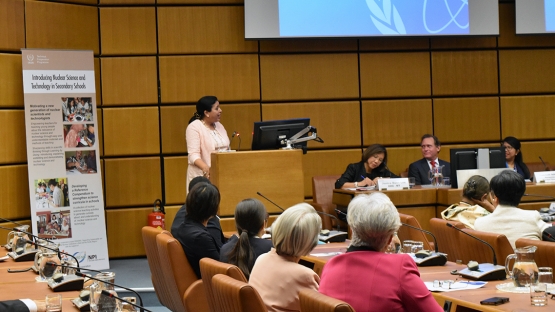Tomorrow's scientists are today's students, and how can we inspire the next generation to choose science as a career? That's the question that a new educational resource package developed by the IAEA in partnership with education and communication experts from around the world aims to answer. The Compendium of Resources and Activities on Nuclear Science and Technology for Secondary School Teachers and Students, presented this week at a side event entitled 'Introducing Nuclear Science and Technology in Secondary Schools' on the margins of the 60th IAEA General Conference, aims to make nuclear science more interesting and attractive to students, and to encourage young people to enter the fields of nuclear science and technology.
"We need innovative techniques to address the challenges of the future, and we need to ensure that the nuclear knowledge is passed on to the next generations. This project is an opportunity for the youth, for developing countries, for women!" said Ms Najat Mokhtar, Director of the IAEA's Division for Asia and the Pacific in her opening statement to the side event.
Retaining and developing nuclear knowledge and capacity is essential for sustainability and future development. Scientists and researchers, including in the nuclear field, are urgently needed to respond to the needs of a rising global population, urbanization, industrialization, and the challenges of climate change. Today's students can be tomorrow's scientists – the generation that will take over from the scientists who will be retiring within the next decade – and engaging their interest while still in high school is key to ensuring a cohort of students and graduates interested in pursuing careers as scientists, and ready to take on the challenge of developing nuclear knowledge and capacity in their countries.
The Compendium is one of the outputs of a pilot IAEA technical cooperation project in the Asia and the Pacific region that was designed to support information, education and communication about nuclear science and technology among secondary school students and teachers in the region. It offers an assortment of resources, programmes and activities that have proven to enrich scientific learning in an engaging manner in secondary schools. It is a guide to the latest teaching resources and tips, and it provides a list of classroom and afterschool activities that teachers and students can use to teach science in a more engaging, interesting and easy to understand way. These include activities like Science on Saturday (SOS), essay competitions, workshops for teachers and students, field trips, hands on experiments and POWER SET (Powerful Opportunities for Women Eager and Ready for Science, Engineering and Technology).








